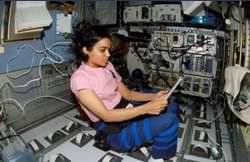Kalpana Chawla (PH.D.)
Payload Specialist
 Personal Data: Born in Karnal, India.
Kalpana Chawla enjoys flying, hiking, back-packing, and reading.
She holds Certificated Flight Instructor's license with airplane
and glider ratings, Commercial Pilot's licenses for single- and
multi-engine land and seaplanes, and Gliders, and instrument rating
for airplanes. She enjoys flying aerobatics and tail-wheel
airplanes.
Personal Data: Born in Karnal, India.
Kalpana Chawla enjoys flying, hiking, back-packing, and reading.
She holds Certificated Flight Instructor's license with airplane
and glider ratings, Commercial Pilot's licenses for single- and
multi-engine land and seaplanes, and Gliders, and instrument rating
for airplanes. She enjoys flying aerobatics and tail-wheel
airplanes.
Education: Graduated from Tagore School,
Karnal, India, in 1976. Bachelor of science degree in aeronautical
engineering from Punjab Engineering College, India, 1982. Master of
science degree in aerospace engineering from University of Texas,
1984. Doctorate of philosophy in aerospace engineering from
University of Colorado, 1988.
Experience: In 1988, Kalpana Chawla started
work at NASA Ames Research Center in the area of powered-lift
computational fluid dynamics. Her research concentrated on
simulation of complex air flows encountered around aircraft such as
the Harrier in "ground-effect." Following completion of this
project she supported research in mapping of flow solvers to
parallel computers, and testing of these solvers by carrying out
powered lift computations. In 1993 Kalpana Chawla joined Overset
Methods Inc., Los Altos, California, as Vice President and Research
Scientist to form a team with other researchers specializing in
simulation of moving multiple body problems. She was responsible
for development and implementation of efficient techniques to
perform aerodynamic optimization. Results of various projects that
Kalpana Chawla participated in are documented in technical
conference papers and journals.
NASA Experience: Selected by NASA in December
1994, Kalpana Chawla reported to the Johnson Space Center in March
1995 as an astronaut candidate in the 15th Group of Astronauts.
After completing a year of training and evaluation, she was
assigned as crew representative to work technical issues for the
Astronaut Office EVA/Robotics and Computer Branches. Her
assignments included work on development of Robotic Situational
Awareness Displays and testing space shuttle control software in
the Shuttle Avionics Integration Laboratory.
 In November, 1996, Kalpana Chawla was assigned as
mission specialist and prime robotic arm operator on STS-87
(November 19 to December 5, 1997). STS-87 was the fourth U.S
Microgravity Payload flight and focused on experiments designed to
study how the weightless environment of space affects various
physical processes, and on observations of the Sun's outer
atmospheric layers. Two members of the crew performed an EVA
(spacewalk) which featured the manual capture of a Spartan
satellite, in addition to testing EVA tools and procedures for
future Space Station assembly. In completing her first mission,
Kalpana Chawla traveled 6.5 million miles in 252 orbits of the
Earth and logged 376 hours and 34 minutes in space. In January,
1998, Kalpana Chawla was assigned as crew representative for
shuttle and station flight crew equipment. Subsequently, she was
assigned as the lead for Astronaut Office’s Crew Systems and
Habitability section.
In November, 1996, Kalpana Chawla was assigned as
mission specialist and prime robotic arm operator on STS-87
(November 19 to December 5, 1997). STS-87 was the fourth U.S
Microgravity Payload flight and focused on experiments designed to
study how the weightless environment of space affects various
physical processes, and on observations of the Sun's outer
atmospheric layers. Two members of the crew performed an EVA
(spacewalk) which featured the manual capture of a Spartan
satellite, in addition to testing EVA tools and procedures for
future Space Station assembly. In completing her first mission,
Kalpana Chawla traveled 6.5 million miles in 252 orbits of the
Earth and logged 376 hours and 34 minutes in space. In January,
1998, Kalpana Chawla was assigned as crew representative for
shuttle and station flight crew equipment. Subsequently, she was
assigned as the lead for Astronaut Office’s Crew Systems and
Habitability section.
 Classic Aero-TV: VerdeGo Debuts VH-3 Hybrid-Electric Powerplant
Classic Aero-TV: VerdeGo Debuts VH-3 Hybrid-Electric Powerplant NTSB Prelim: Grumman American Avn. Corp. AA-5B
NTSB Prelim: Grumman American Avn. Corp. AA-5B ANN's Daily Aero-Linx (12.02.25)
ANN's Daily Aero-Linx (12.02.25) Aero-News: Quote of the Day (12.02.25)
Aero-News: Quote of the Day (12.02.25) Aero-News: Quote of the Day (12.03.25)
Aero-News: Quote of the Day (12.03.25)




